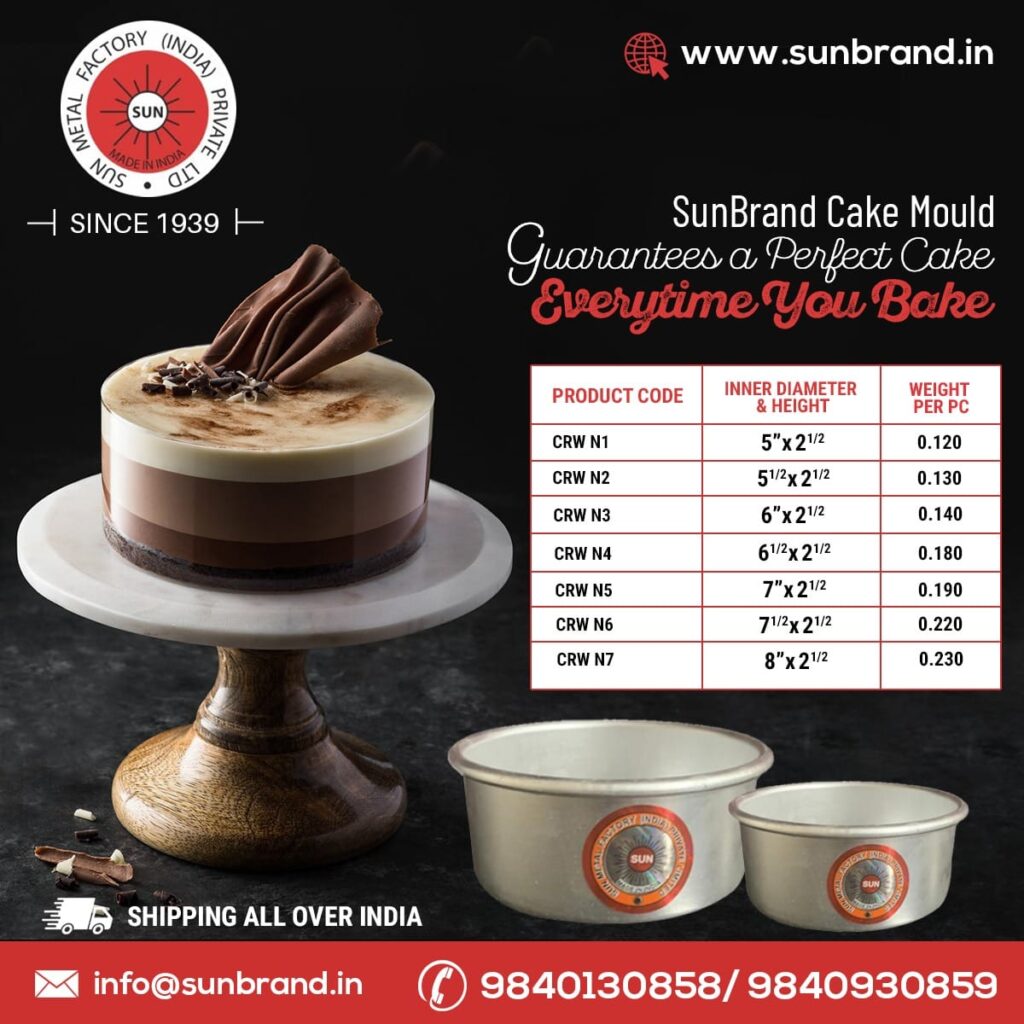Baking cake is an art that can be mastered with the right choice of cake mould. Ln general Cake moulds come in two different shapes: Round cake mould, or square cake mould. Compared to all the materials used for making cake pans aluminium is considered better. These metal cake moulds have non-tick coatings or are anodized to make baking easier. It’s much easier to use a non-stick cake mould. Because non-stick makes cooking and cleaning a breeze. Similarly, anodized cake mould has its own set of advantages.
No matter what type of cake mould you use, it needs proper care so that your baking process becomes hassle-free. Stuck on food and stains can be sometimes hard to remove even after hours of scrubbing and washing. Here are a few tips to clean and care for your cake mould.
Why aluminuim cake mould is better than other materials?
It’s just as vital to know what kind of material your bakeware is composed of as it is with pots and pans.
Aluminium: It is the most often used cake mould/tin material in India. It’s cost-effective, extremely long-lasting, and simple to use. Because the mould is not non-stick, it is imperative that it be well greased. It also conducts heat efficiently due to its metallic composition, allowing for even heating and baking of your cakes. If you’re a newbie looking for a cake mould, SunBrand aluminium cake mould is a great option! It’s so widespread that even professionals use it!
Anodized aluminum: Aluminum that has been anodized is a nonreactive baking pan material. The light hue of this pan keeps the bottom crust light and fluffy, with less wrinkling than darker pans. Anodized aluminium reaches suitable baking temperatures and cools down rapidly because it reflects heat rather than absorbing it.
Aluminum non-stick cake moulds: It is an ideal option for those who want a simple and hassle-free baking experience. SunBrand Non-stick cake moulds are easy to clean and maintain. It does not require greasing or oiling hence less fat. These cake moulds are very affordable and saves a lot of time in cleaning and washing. It evenly distributes heat hence you can yield an evenly baked cake every time you bake.
Common cleaning method:
Sometimes there are chances that food might get burnt. Even if you are a professional baker you cannot avoid such tragedies. Whatever material cake mould it may be this single tip can come handy. This method can remove all spots, stains and discolorations.
- If there is any burnt on grease or stuck on food use a paper towel to wipe the mould clean
- Make a paste with 1 tablespoon baking soda and vinegar. Apply the paste on the stained areas. Allow the mixture to sit for 3-5 minutes.
- Now, fill the sink with hot water and add some dishwasher. Let the cake mold soak in the sink filled with water and dishwater for 5 minutes.
- If you are using an aluminum cake mould scrub it using a steel wool. In case your cake mould has non-stick coating or anodized coating then use only nylon scrubs or soft non—abrasive scrubs to remove any dirt.
- Wash as dry the cake mould as usual.
To remove discoloration
If there is discoloration on your aluminium cake mould then clean it suing cream of tartar or lemon juice.
- Fill the cake mould with water
- Add 1 tablespoon of cream of tartar to the water
- Now, heat the mixture for a few minutes in the oven or until the discoloration is removed.
- If you don’t have cream of tartar in hand then use 1 tablespoon of lemon juice to per quart of water.
Another method
- Fill the cake mould with water and add some apple peels.
- Now, boil the mixture on stove top. Let t simmer for 30 minutes.
- Once the mixture cools down pour the water out and wash it as asual using dish washing liquid and scrubber.
To remove baked on mess
Baked on mess can be hard to remove if the cake mould dries up. So to remove the baked on mess cake mould has to be rinsed or moist before cleaning.
- Dust the inner surface of the cake mould with oxalic acid powder. Let it form a paste with the rinsed water left on the surface.
- Let the mixture sit for 5 minutes. Make sure to add more oxalic acid powder to the surfaces that have more dirt and grease.
- Scrub the mould using a sponge or non-abrasive scrubber. Then, rinse it with soap and water as usual.
To remove stubborn residue
- Make a paste with very little amount of baking soda, 2-3 pinches of salt and white vinegar.
- Apply the paste to the inner surface of the cake mould
- Let the mixture sit on the cake mould for about 2 hours.
- Finally, rinse and wash the cake mould as usual using a soap and sponge.
Do’s and Don’ts of cleaning an aluminum cake mould
Do’s
- Do use aluminum friendly detergents and dishwashing liquids
- Do use baking soda sparingly when cleaning aluminum bakewwars as it can damage the surface of the metal.
Don’ts
- Do not wash your aluminum cake moulds in a dishwasher. The intense heat and chemical inside the dishwasher harms the metals and damages it.
- Do not use abrasive scrubbers as it can damage the surface of the cake mould. Instead soak them before washing so the stuck on dirt of food can be rinsed away easily.
- Do not use lemon juice or tomato juice to clean anodized aluminum cake mould.

